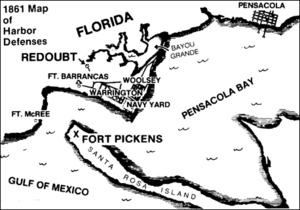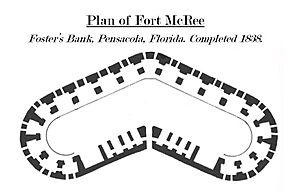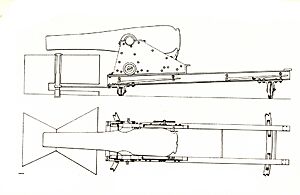Fort McRee facts for kids

Fort McRee was an old military fort built by the United States in Florida. It stood on the eastern tip of Perdido Key. Its main job was to protect Pensacola and its important natural harbor.
Fort McRee was part of a team of forts defending Pensacola Bay. The other forts were Fort Pickens, located across the water on Santa Rosa Island, and Fort Barrancas, which was across Pensacola Bay. Today, Fort Barrancas is part of Naval Air Station (NAS) Pensacola. Fort Pickens was the biggest of these three forts. Sadly, very little of Fort McRee remains today.
Contents
History of Fort McRee
Building a Unique Fort
Fort McRee was one of three main forts built by the United States. They were constructed to make Pensacola Bay safer after the War of 1812. Building Fort McRee took a long time, from 1834 to 1839.
The fort had three levels and a separate water battery close to the sea. It was on a sandy area called Foster's Bank. Its shape was very unusual, like a boomerang. This was because it had to fit on a small, narrow barrier island.
Fort McRee had 19 casemates, which were strong, arched rooms. Each casemate could hold up to four cannons. However, some of these rooms were used for soldiers' living areas or storage. This meant fewer cannons were placed in some parts of the fort. Still, 44 cannons faced Pensacola Pass, ready to stop enemy ships.
The back wall of the fort, called the gorge, had the main entrance, known as the Sally Port. This entrance was 12 feet wide. The gorge also had large rooms used for storing gunpowder.
Even though the fort was finished in 1839, its 122 guns weren't put in place until 1843 to 1845. There were some problems, like the wooden floors on the second level starting to rot.
In April 1840, the fort was named Fort McRee. It was named after an Army engineer named Colonel William McRee.
Early Days at the Fort
The first soldiers arrived at Fort McRee on May 2, 1842. They were joined by more troops in July. From then until October 1845, soldiers were stationed at the fort at different times.
After the Mexican–American War ended in 1848, new barracks were built near Fort Barrancas. After this, soldiers only manned Fort McRee for drills and target practice. The US Army was small back then, so troops were used carefully. The other Pensacola forts were also used this way until the Civil War began.
Fort McRee in the Civil War
In January 1861, the Civil War was about to begin. The Union Army officer in charge, First Lieutenant Adam J. Slemmer, had very few men. He decided to move his small force to the safer Fort Pickens. On January 8, 1861, Union soldiers at Fort Barrancas fired on the Florida Militia. This was one of the first shots of the war.
On January 9 and 10, 1861, his soldiers made the cannons at Barrancas and McRee unusable. Then they moved across the bay to Fort Pickens. This move was just in time. On January 12, soldiers from Florida and Alabama arrived and took over the empty forts.
Over the next few months, both sides built new cannon batteries. They also brought in more soldiers. The two sides often fired cannons at each other, but not much damage was done. By the end of 1861, about 7,000 Confederate soldiers faced 2,000 Union soldiers around Fort Pickens.
On October 9, 1861, Confederate General Braxton Bragg ordered an attack on Fort Pickens. This attack was not successful. The Union commander, Colonel Harvey Brown, decided to strike back. Fort McRee was the closest Confederate fort to Fort Pickens. It was also blocking any attack on Pensacola. So, it became the main target.
On the morning of November 22, 1861, Union forces heavily attacked Fort McRee. Cannons from Fort Pickens fired at it. Two Union ships, the Niagara and the Richmond, also joined the attack.
At first, the Confederates fired back strongly. They even badly damaged the Richmond. But the combined fire from the ships eventually silenced a nearby Confederate battery. By 5 PM, the cannons at Fort McRee also stopped firing. The ships had to leave because the tide was low and it was getting dark.
After the day's fighting, General Bragg checked the damage. The commander of Fort McRee, Colonel John B. Villepique, said his fort was badly exposed. Half of its weapons were broken, and the gunpowder was unprotected. Villepique asked to destroy the fort and leave. But Bragg refused, worried about how a retreat would affect his soldiers and the enemy.
At 10 AM on November 23, the Niagara started attacking Fort McRee again. The cannons at Fort Pickens also fired. But the guns of Fort McRee remained silent. The fighting ended that day, marking the end of Colonel Brown's attack.
Fort McRee survived, but it was badly damaged. Large parts of its walls were blown away. Other sections had holes shot right through them. In one area, a whole section of the wall fell down. Most of the wooden floors inside the fort had burned. One gunpowder storage room collapsed, killing six Confederate soldiers.
The fighting on November 22 and 23 was the last time Fort McRee saw battle. Although there was another cannon fight on January 1, 1862, Fort McRee did not take part.
When Confederate forces left Pensacola in May 1862, they burned Fort McRee. They also burned other buildings they thought were important. There are no records showing that Union forces ever tried to repair the fort.
Years of Neglect
Fort McRee remained damaged and burned for the next 30 years. The only work done was to build two jetties to stop the beach from washing away. In 1875, the War Department allowed bricks to be taken from Fort McRee. These bricks were used to build walkways and repair Fort Barrancas.
In 1885, some business people wanted to buy the remains of Fort McRee for $500. But the Army Corps of Engineers said no. They felt the bricks were more valuable to the War Department for repairing other forts.
New Life for Coastal Defense
Later, there was new interest in making US coastal defenses stronger. So, activity returned to Fort McRee. In 1898, a new battery of two large guns was built near the fort. It was named Battery Slemmer, after the Union officer who moved troops from Pensacola at the start of the Civil War.
In 1899, another battery of fast-firing guns was installed. It was named Battery Center. Soldiers from the US Army Coast Artillery Corps manned these batteries. About 50 to 100 soldiers rotated from Fort Barrancas to Fort McRee.
A hurricane hit on September 26-27, 1906. It destroyed most of the newer buildings built since 1898. After the hurricane, only a small group of caretakers stayed at the site. When America entered World War I in 1917, the guns from Battery Slemmer were removed. They were sent to Europe to be put on railway cars. In 1920, the guns from Battery Center were also removed. With no guns left, Fort McRee became unused again.
Last Military Use
When World War II began, activity returned to Fort McRee one last time. Plans were made for a battery of two powerful 6-inch guns. These guns could shoot up to 15 miles. The foundations for the guns were built, and the gun parts arrived. However, the war ended before the guns were put in place. This site, called Battery 233, was then abandoned.
After World War II, fixed coastal defenses were no longer needed. In 1947, Fort Barrancas was closed as a military post. Its ownership was given to NAS Pensacola. Fort McRee, being a smaller part of Barrancas, was included in this transfer.
The US Navy managed the forts until 1971. Then, Fort Barrancas and Fort Pickens were given to the National Park Service. They became part of Gulf Islands National Seashore. This ended nearly 140 years of military ownership for Fort McRee.
Fort McRee Today
Of the three forts that once protected Pensacola, Forts Pickens and Barrancas were saved. They were either used for a long time or became historic sites. But Fort McRee was in a remote spot, only reachable by walking or boat. So, it was left to nature. Storms and erosion slowly wore it away. Today, only a few scattered foundations remain.
The land where Fort McRee once stood now belongs to the National Park Service. Anyone visiting Gulf Islands National Seashore can go there. However, the area is remote, and there are no visitor facilities. Also, using metal detectors is not allowed. Any old items found must not be removed from the site.
Where Exactly Was Fort McRee?
The exact location of Fort McRee is a bit of a mystery. The area, Foster's Bank, has changed a lot over the last 170 years. The beach has shrunk and grown due to weather and the sea. Wars, fires, storms, and even reusing bricks have left very little of the fort. All these things make it hard to find clear physical evidence of the old structures.
Adding to the confusion are two different sets of coordinates for the fort. These were listed by the US Coast Guard in an 1882 survey. One set of coordinates places the fort on the shore where Foster's Bank is today. The other set of coordinates places the fort underwater, just off the beach.



